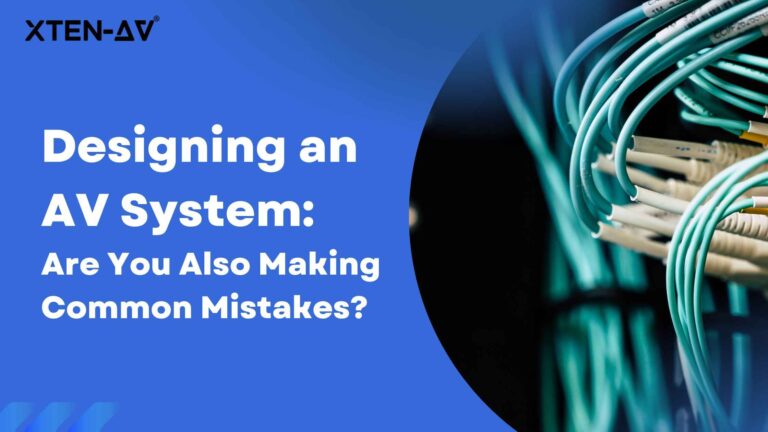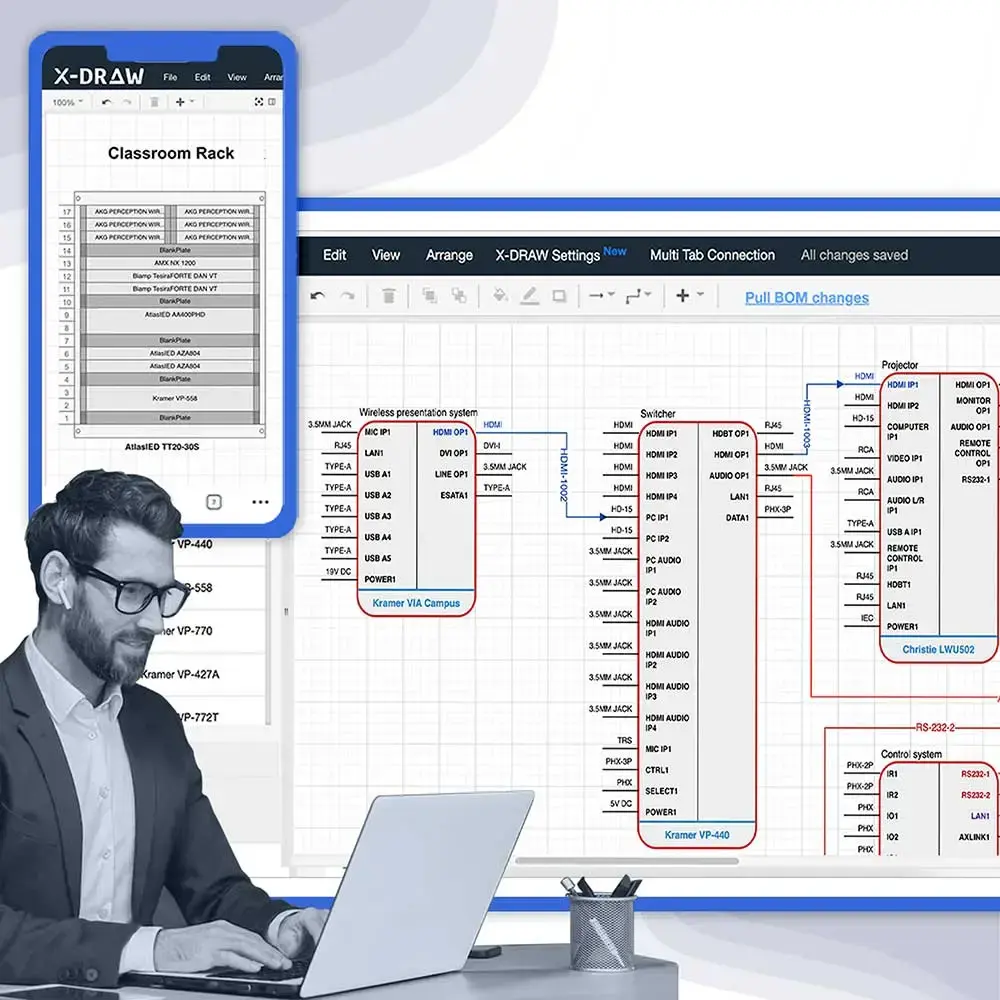AV System Design: Avoid These Common Mistakes Most Audio Visual Designer Ignore!
Hey there, audio visual enthusiasts! Ever wondered what goes on behind the scenes to create those jaw-dropping audiovisual experiences? It’s all about AV system design! So, buckle up, and let’s dive into this captivating world of AV technology and creativity.
Audiovisual system design is the art and science of crafting seamless and immersive audiovisual setups. It’s like being a maestro, orchestrating a symphony of projectors, displays, speakers, and control systems to create an unforgettable experience. But here’s the secret sauce that takes your design skills to the next level.
Introducing X-DRAW, the nifty tool that AV system designers swear by! It’s like having a magic wand that simplifies the entire design process with a touch of whimsy. With X-DRAW, you can effortlessly create detailed diagrams, implement advanced AV-specific customizations (like automatic cable labeling, title block styling, scaling and more) and automate drawings and documents within minutes.
This amazing tool is designed to upgrade your AV capabilities and streamline your workflow. Want to impress your clients with stunning AV designs? We got your back! You can use our customizable design templates that are created by AV experts, helping you save time and auto-generate your BOM, drawings and proposals.
But here’s the best part: X-DRAW doesn’t just make you look like an AV rockstar, it also enhances collaboration. You can easily share your designs with clients and team members, gather feedback, and make adjustments on the fly. It’s like a virtual playground for AV aficionados!
The all-in-one solution for your AV needs
Transform your audio-visual experience with XTEN-AV.
No Credit Card required
Upgrade Your AV System Design Process with XTEN-AV’s Automated Features
AV Design Mastery + Winning Proposals = 10x Productivity!
- Automatic Cable Labeling & Styling
- 100+ Free Proposal Templates
- Upload & Create Floor Plans
- 1.5M Products from 5200 Brands
- AI-powered ‘Search Sense'
- Legally Binding Digital Signatures
No Credit Card Required
Key Takeaways
- How to avoid common mistakes in AV system design that are usually made by audiovisual experts.
- Offer clients accurate and precise drawings with an amazing Audio visual system design software that no one talks about.
- Tried and tested tips to help you conquer the world of audio-video designs like a pro.
What Is AV System Design?
AV system design is the process of creating and planning a comprehensive audiovisual solution. It involves AV integration and control systems to deliver a seamless user experience. This includes understanding the client’s needs, analyzing the physical space, and considering technical requirements.
An audio-video expert assesses the environment, determines equipment placement, designs wiring diagrams, and creates a system that meets the client’s objectives and budget. The design process also involves selecting appropriate av system components, specifying equipment, and planning for optimal performance, aesthetics, and functionality.
Ultimately, audio visual system design aims to create an immersive and efficient audiovisual solution tailored to the client’s specific requirements.
Audio Visual System Design Process to Avoid the Common Mistakes!
When we start the integrated systems design process, the first thing to remember is proving the top-notch audio-visual experience that your client deserves. Keeping this in mind you will proceed further with the steps we have listed below. This process will actually simplify your audio visual system design process and aims to give you 10X productivity in your business.
Gather Requirements
This is the basic and most important step when we talk about the audio visual system design process. You will have to understand the client’s needs, goals, and expectations from their av control systems. With this information, you will process knowing you and your client are on the same page.
Assess The Space
The next step would include assessing the space your clients want to set up their AV systems. Evaluate the physical environment fully where the system will be installed, including the dimensions of the room, lighting conditions, acoustics, and any other architectural constraints.
Determine Equipment And Technology
Then according to the requirements and space available, figure out the equipment and technology, you will put in use to give the best results to your clients. The equipment could include projectors screens, cameras, microphones, and audio visual control systems. Remember all this will depend on what your client needs.
Design System Layout
Here comes the most crucial work, creating a proper and presentable layout. We know this can be a nightmare for most AV integrators, but why worry? We have X-DRAW to your rescue. This is the first AI-powered audio-video tool that will enable you to create a layout that is ready to impress your clients and close deals.
Develop Integration And Control Strategy
Then you will also have to define how different AV components will interact and communicate with each other. You can use X-DRAW for this as well, our tool enables you to easily create line schematics with proper measurements. This way you can invest your precious time in a more important part of your business.
Test and Optimize
The most important step will be to install the audio video system at the location and perform rigorous testing to make sure it’s functioning properly and as per your client’s requirements. Ensure that the client is present in front of you so they can adjust any kind of setting and learn how the system is operated.
AV Design Mastery + Winning Proposals = 10x Productivity!
- Automatic Cable Labeling & Styling
- 100+ Free Proposal Templates
- Upload & Create Floor Plans
- 1.5M Products from 5200 Brands
- AI-powered ‘Search Sense'
- Legally Binding Digital Signatures
No Credit Card Required
9 Tips For AV System Design That Will Help You Become A Pro Audio Visual Designer!
When navigating and carrying out an audio video design with the necessary competence, especially if you are new to the business, you could find it challenging at times. So why fret? We’ve put up a few crucial pointers so you may effortlessly advance your AV design. You will undoubtedly get outcomes you never imagined if you diligently implement the advice provided here.
Plan And Organize
Before starting any AV system design project, take the time to plan and organize your workflow. Clearly define the project scope, establish goals, and create a timeline to ensure efficient project management.
Utilize A Design Tool
Incorporating av system design software like XTEN-AV’s X-DRAW tool can greatly enhance productivity. This tool allows audiovideo integrators to create detailed system diagrams, design layouts, and easily collaborate with team members or clients. Upgraded AV-specific capabilities take you away from manual drawing and diagramming, increasing efficiency and accuracy of your AV designs.
Standardize Templates
Develop standardized templates for different types of audiovisual system designs. These templates can include common equipment configurations, schematic diagrams, and control system layouts. By using templates, you can save time and ensure consistency across projects. Check out the range of different AV design templates offered by X-DRAW.
Maintain A Component Library
Create a library of commonly used AV components, including detailed specifications, product images, and av system installation guidelines. This library will save you time during the design phase by providing easy access to accurate information.
XTEN-AV library and the ‘My Library’ feature can give you easy access to and help you keep on top of all your favored products.
Automate Documentation
Implement tools that automate the generation of project documentation, such as equipment lists, cable schedules, and rack layouts. This automation eliminates manual data entry and reduces the chance of errors.
Collaborate Effectively
Foster efficient collaboration within your team by using cloud-based platforms or project management tools. These tools allow team members to work simultaneously on different aspects of the AV system design, share feedback, and track progress.
Stay Updated With Industry Trends
The AV industry is constantly evolving, with new technologies and standards emerging. Stay updated with the latest trends, attend industry conferences, and participate in training programs to expand your knowledge base and ensure your designs are cutting-edge.
Streamline Communication With Clients
Effective communication with clients is crucial for successful audio-visual system design. Clearly understand their requirements, provide regular project updates, and address any concerns promptly. Tools like X-DRAW can help you visually communicate your audio visual design concepts to clients.
Conduct Thorough Site Surveys
Prior to designing an audiovisual system, conduct comprehensive site surveys to assess the space, identify potential challenges, and determine optimal equipment placement. This proactive approach will help avoid surprises during the AV installation phase.
Conclusion
This was a guide to help AV integrators perform better at designing and what are the essential steps when we talk about AV designing. The step-by-step instructions in the tutorial will help you completely comprehend the significance of organizing and putting an AV design into action.
Make sure to apply and follow the tips we have provided to improve your efficiency and close clients like a pro. XTEN-AV also has pre-made AV proposal templates that are free to use. More than 100 businesses have used and benefited from our proposals, try and experience the difference yourself!
Frequently Asked Questions
Designing a proper AV system can help businesses achieve a lot more than they could expect. Here are a few benefits AV designers could offer businesses.
- Customized solutions
- Expertise & experience
- Seamless Integration
- Scalability & future proofing
- Streamlines project Management
- Enhances user experience
- Ongoing support & maintenance
As an AV design company, these are the benefits you should be offering to any business that onboards your services.
It guarantees seamless integration of audio, video, and control systems, audiovisual system design is important for producing an effective and immersive experience. The right design optimizes user experience, maximizes performance, and synchronizes technology with organizational needs.
The hardware and software solutions that provide centralized administration and control of audiovisual equipment are referred to as control systems in AV design. For user friendliness and system effectiveness, they make it easier to do tasks like switching inputs, changing volume, activating/deactivating devices, and developing automated control scenarios.
Designing audio for an AV system involves analyzing the acoustic properties of the space, determining speaker placement, selecting appropriate audio components, and configuring settings for optimal sound reproduction. Equalization, room correction, and proper calibration are essential to achieve clear, balanced, and immersive audio.


